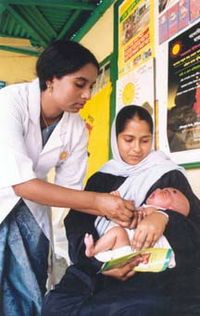
Photo from wikipedia
Background. Because the cardiovascular mortality in Hungary is high, particularly among the socio-economically deprived and the Roma, it is implied that primary health care (PHC) has a limited ability to… Click to show full abstract
Background. Because the cardiovascular mortality in Hungary is high, particularly among the socio-economically deprived and the Roma, it is implied that primary health care (PHC) has a limited ability to exploit the opportunities of evidence-based preventions, and it may contribute to social health inequalities. Objectives. Our study investigated the underuse of PHC preventive services. Methods. Random samples of adults aged 21–64 years free of hypertension and diabetes mellitus were surveyed with participation rate of 97.7% in a cross-sectional study. Data from 2199 adults were collected on socio-demographic status, ethnicity, lifestyle and history of cardio-metabolic preventive service use. Delivery rates were calculated for those aged 21–44 years and those aged 45–64 years, and the influence of socio-demographic variables was determined using multivariate logistic regression. Results. Delivery rates varied between 12.79% and 99.06%, and the majority was far from 100%. Although most preventive service use was independent of education, younger participants with vocational educations underutilized problematic drinking (P = 0.011) and smoking (P = 0.027) assessments, and primary or less educated underutilized blood glucose (P = 0.001) and serum cholesterol (P = 0.005) checks. Health care measures of each lifestyle assessment (P nutrition = 0.032; P smoking = 0.021; P alcohol = 0.029) and waist circumference measurement (P = 0.047) were much less frequently used among older Roma. The blood glucose check (P = 0.001) and family history assessment (P = 0.043) were less utilized among Roma. Conclusions. The Hungarian PHC underutilizes the cardio-metabolic prevention contributing to the avoidable mortality, not generating considerably health inequalities by level of education, but contributing to the bad health status among the Roma.
Journal Title: Family Practice
Year Published: 2017
Link to full text (if available)
Share on Social Media: Sign Up to like & get
recommendations!